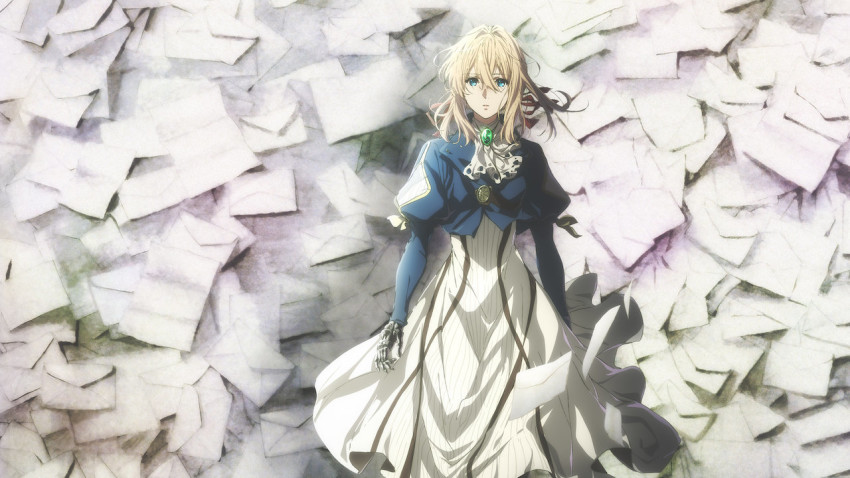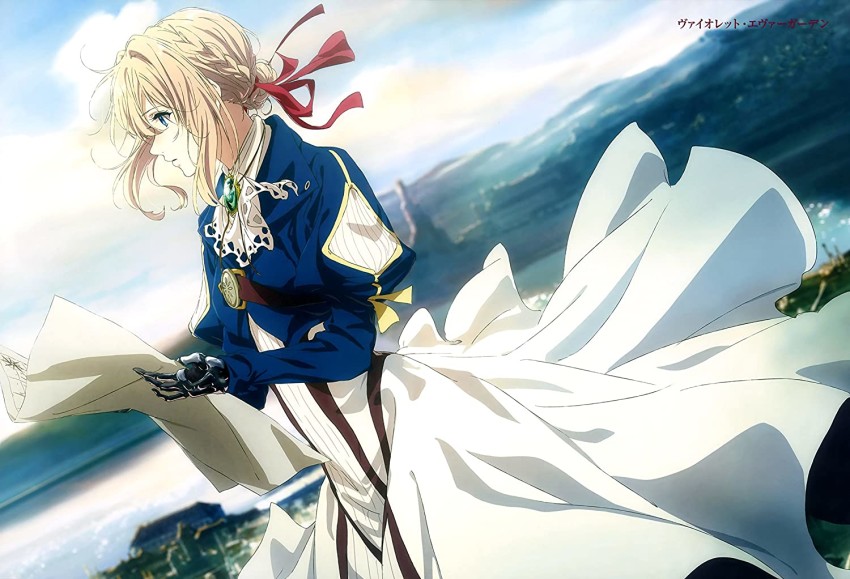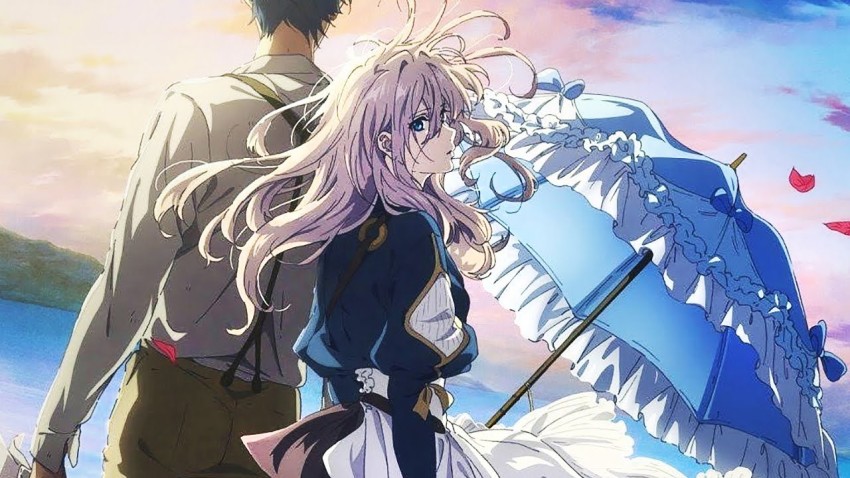Violet Evergarden
October 2, 2020 · 0 comments
By Andrew Osmond.
 Violet Evergarden is set in an alternative world, told across a cluster of countries which often look European. These countries have been in a terrible war with each other, but a ceasefire has been signed. Now a new peacetime industry is springing up, an organised postal service, which is as important in this world as the Internet is in ours. But as many people have no experience in putting their intimate feelings on paper, a new profession has sprung up to help them write their letters. These professionals are called Auto Memory Dolls.
Violet Evergarden is set in an alternative world, told across a cluster of countries which often look European. These countries have been in a terrible war with each other, but a ceasefire has been signed. Now a new peacetime industry is springing up, an organised postal service, which is as important in this world as the Internet is in ours. But as many people have no experience in putting their intimate feelings on paper, a new profession has sprung up to help them write their letters. These professionals are called Auto Memory Dolls.
And no, they’re not robots; their name comes from the typewriters they use. They’re simply young women – scribing and ghost-writing are clearly viewed as female callings – trained to channel their clients’ feelings. But there’s one Doll who might be taken as a robot. She’s mostly expressionless, scarily efficient – her typing speed would rival Clark Kent’s – and she has huge trouble comprehending emotions, especially her own. It’s blindingly obvious that she’s hopelessly, piteously in love with her missing military superior, who probably died in the war. For the woman is a former child soldier, Violet Evergarden.
Broadcast in 2018, Violet Evergarden was a major departure for its production studio Kyoto Animation. The great bulk of the studio’s past work had been set in Japan, mostly with school-age protagonists and often set at school. Arguably Evergarden’s closest relative at the studio was its recent film, A Silent Voice. Although that was another school drama, it was about the aftermath of trauma, where characters who are emotionally inarticulate must come to terms with dark experiences.
Violet’s origins are left largely shadowed at the start of the series, though we’re shown she was a deadly soldier with a huge kill count. She’s lost both her arms, having them replaced with silver prostheses. Eerily beautiful, they’re the show’s one big piece of “steampunk” retro-tech, reminding anime fans of Ed Elric’s automail in Fullmetal Alchemist. Violet speaks with impeccable (mechanical?) politeness and precision, but a four-year-old would understand feelings better than she does. Of course, Violet seems absurdly unsuited to conveying the emotions of other people, and yet she can learn to do so.
 Violet’s obvious relatives are in screen science-fiction. Her backstory, for example, echoes numerous anime characters, and not just girls. In the first episode, a woman offers to adopt Violet, mentioning she lost her son in the war. Violet responds, “I can’t become a replacement for your lost child.” Deliberately or not, it feels like a reference to Osamu Tezuka’s Astro Boy, where a robot was created as a substitute for a lost child, then discarded when it couldn’t fill that role. Violet sees herself as a weapon who only exists to fight – it’s her reality, what she was trained to think. In anime, that aligns her with many fighting girls in mecha series, such as Evangelion’s Rei and multiple Gundam characters, such as Soma in Gundam 00.
Violet’s obvious relatives are in screen science-fiction. Her backstory, for example, echoes numerous anime characters, and not just girls. In the first episode, a woman offers to adopt Violet, mentioning she lost her son in the war. Violet responds, “I can’t become a replacement for your lost child.” Deliberately or not, it feels like a reference to Osamu Tezuka’s Astro Boy, where a robot was created as a substitute for a lost child, then discarded when it couldn’t fill that role. Violet sees herself as a weapon who only exists to fight – it’s her reality, what she was trained to think. In anime, that aligns her with many fighting girls in mecha series, such as Evangelion’s Rei and multiple Gundam characters, such as Soma in Gundam 00.
Star Trek, meanwhile, popularised the image of the hyper-capable character who seems inhumanly emotionless. In many scenes, Violet seems especially reminiscent of the loveable android Data in Star Trek: The Next Generation, played by Brent Spiner. Multiple characters in Violet Evergarden see Violet as a doll, an uncanny machine. But of course, the whole point of the story is Violet isn’t a doll, an android or an alien. She’s a completely human girl who’s just been raised in horrible circumstances, never allowed to learn what being human means.
“It’s not that she doesn’t have feelings, she simply doesn’t understand them,” the series director Taichi Ishidate told JMag. “Violet herself expresses that in a line, ‘I don’t understand love’.” Violet is desperate to understand the word, as the last thing that her army commander told her was that he loved her. “This shows that she isn’t a robot that doesn’t have emotions; she simply hasn’t been taught about emotions by anyone yet, and is starting from zero in that respect.”
In the series, Violet is voiced in Japanese by the actress Yui Ishikawa, who also voices the giant-killing warrior Mikasa in Attack on Titan. Mikasa and Violet are plainly on the same emotional spectrum. Mikasa had her own childhood horrors; she’s also inhumanly calm and controlled (which is why she’s a deadly warrior like Violet), so it’s shocking when her passions do break out.
“At first (Violet) does not have emotions,” Ishikawa said,” so she cannot even cry when she is sad. Playing that was really distressing. That made me realise how lucky I am that I have emotions…” On Violet’s development, Ishikawa said, “The change is very gradual because Violet’s maturation is gradual, too. I added emotional responses, but very slowly. I cannot tell you exactly what I did, but I added a little bit of warmth as each episode went, and because she starts to smile as the story develops, I started raising the corners of my mouth more.”
 Ishidate reveals that Violet’s character determined how her world should be depicted – especially the coastal city of Leiden where the postal service is based. The source stories, Ishidate said, gave a general image of Europe. “Should we make it a greyish world, like the foggy London in Sherlock Holmes? That is of course not a bad idea, but for a girl like Violet, who is living in the past, the image of a foggy London is simply too compatible with her. We wanted to bring out a sense of incongruity… Having her standing isolated in a warmer, more vivid world would make it feel like she’s out of place, making her stand out in a good way. So in the end, we decided on Italy! Which is why there are many cuts (shots) with palm trees throughout the work.”
Ishidate reveals that Violet’s character determined how her world should be depicted – especially the coastal city of Leiden where the postal service is based. The source stories, Ishidate said, gave a general image of Europe. “Should we make it a greyish world, like the foggy London in Sherlock Holmes? That is of course not a bad idea, but for a girl like Violet, who is living in the past, the image of a foggy London is simply too compatible with her. We wanted to bring out a sense of incongruity… Having her standing isolated in a warmer, more vivid world would make it feel like she’s out of place, making her stand out in a good way. So in the end, we decided on Italy! Which is why there are many cuts (shots) with palm trees throughout the work.”
Much of Violet Evergarden is episodic, showing Violet travelling to different countries and her interactions with a range of characters, from a tempestuous teen princess to a burned-out playwright. This is a show built on thematic connections, telling small tales of human connection. The original prose stories by Kana Atsuki, Ishidate explained, were presented in non-chronological order. The first story in the prose version is actually the story in which Violet goes to help the burned-out playwright, called Oscar, which is retold in part 7 of the anime.
Ishidate, though, thought the anime version should show Violet’s development, even if many of the stories are separate. “We had quite a lot of trouble,” he said of restructuring the story. “Since our primary focus for the anime is depicting Violet’s growth, we rearranged the events to play out in a linear order. We thought it would be easier for the audience to feel how much she had developed this way.” Incidentally, the extra OVA episode, which will be included in the Collector’s Edition of the series, was designed to fit between the fourth and fifth TV episodes.
Many of the early episodes are framed from the viewpoints of characters observing Violet, with the stories accompanied by their voiceover narrations – for example, the ex-soldier in the first episode who runs the postal service. It’s only later, Ishidate says, that more scenes are added to show Violet’s own viewpoint. Then again, the very first scene in the series is Violet’s dream of when she was with her beloved Major. She sees a jewelled brooch and says it’s the same colour as his eyes… but we see it as the colour of her eyes, a welling, swirling vortex of all the feelings she doesn’t know she has.
Andrew Osmond is the author of 100 Animated Feature Films. Violet Evergarden will be released in the UK by Anime Limited.
Leave a Reply